Business is math.
You need to have X leads in your sales pipeline to generate $Y revenue while considering your average lead conversion rate. But conversion rates vary.
For instance, in the B2C segment, the lead-to-sale conversion rate ranges between 1.8% and 19%, depending on your target market.
On the other hand, the lead conversion rate varies from 0.35% to 40% in the B2B segment. But it’s all based on the industry you operate in and how well you manage leads. Using free lead management software can streamline processes, provide visibility into lead journeys, and automate key tasks such as lead assignment and prioritization.
There are no benchmarks, but MarketingSherpa asked 17 marketers to share their lead conversion rate across 12 different industries.
Here’s what they found:
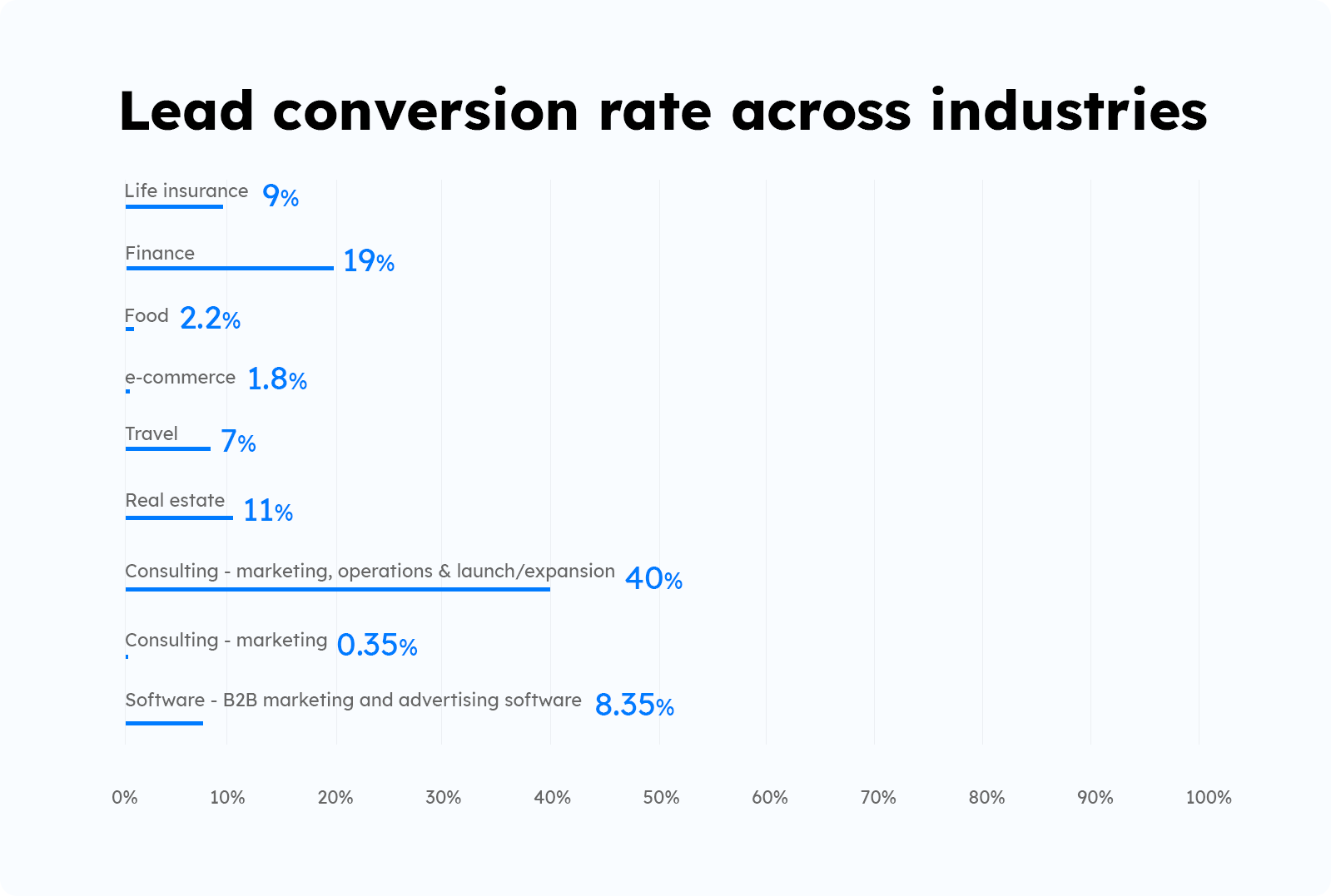
So, if you’re converting at a higher rate than the above, well done – you’re doing great!
However, the problem arises mainly when your conversion rates are below the industry average. It indicates that either you’re not generating enough quality leads or you’re lagging in lead management. That is,
- Your sales pipeline does not contain qualified leads.
- You’re not able to seize all opportunities to sell.
- You’re unable to track if your leads are interacting with your nurturing activities and take corrective measures.
Let’s see how lead management resolves the above challenges and helps you meet and exceed your sales targets.
What is Lead Management?
Lead management is a process of acquiring and organizing lead information and managing interactions with them. It involves capturing leads from multiple sources, qualifying them, distributing them to sales reps, and using lead-tracking software to track and record online and offline interactions, such as emails, ad clicks, website visits, phone calls, and face-to-face meetings.
It refers to the process of capturing, tracking, and nurturing leads throughout the sales funnel. It involves using various tools and strategies to manage leads from the initial contact to conversion. Effective lead management is crucial for businesses to increase sales, improve customer relationships, and stay ahead of the competition.
Lead management helps companies understand customers’ pain points and requirements. And by doing so, they can propose a solution that can serve their customers’ needs.
If you’re wondering how this helps, 47% of buyers say that they are more likely to buy from a seller who is aware of their needs.
Now, let’s look at the various aspects of lead management in detail.
Why Lead Management is Important
Lead management is essential for businesses to succeed in today’s competitive market. By systematically organizing and engaging with potential customers, businesses can ensure that no opportunity is missed and that each lead is given the attention it deserves. This comprehensive approach enhances the efficiency of the sales process and helps build a robust sales pipeline that drives consistent revenue growth.
It helps marketing and sales teams to work together seamlessly, ensuring that leads are properly qualified, nurtured, and converted into customers. By implementing a lead management system, businesses can streamline their sales process, increase efficiency, and reduce costs. Moreover, lead management helps businesses build strong relationships with their customers, increasing customer loyalty and retention. When marketing and sales teams are aligned, they can share valuable insights and data, making identifying and targeting high-quality leads easier. This collaborative approach boosts conversion rates and enhances the overall customer experience, fostering long-term loyalty and advocacy.
Lead Management Process
Lead management is essential for businesses to succeed in today’s competitive market. By systematically organizing and engaging with potential customers, businesses can ensure that no opportunity is missed and that each lead is given the attention it deserves. This comprehensive approach enhances the efficiency of the sales process and helps build a robust sales pipeline that drives consistent revenue growth.
It helps marketing and sales teams to work together seamlessly, ensuring that leads are properly qualified, nurtured, and converted into customers. By implementing a lead management system, businesses can streamline their sales process, increase efficiency, and reduce costs. Moreover, lead management helps businesses build strong relationships with their customers, increasing customer loyalty and retention. When marketing and sales teams are aligned, they can share valuable insights and data, making identifying and targeting high-quality leads easier. This collaborative approach boosts conversion rates and enhances the overall customer experience, fostering long-term loyalty and advocacy.
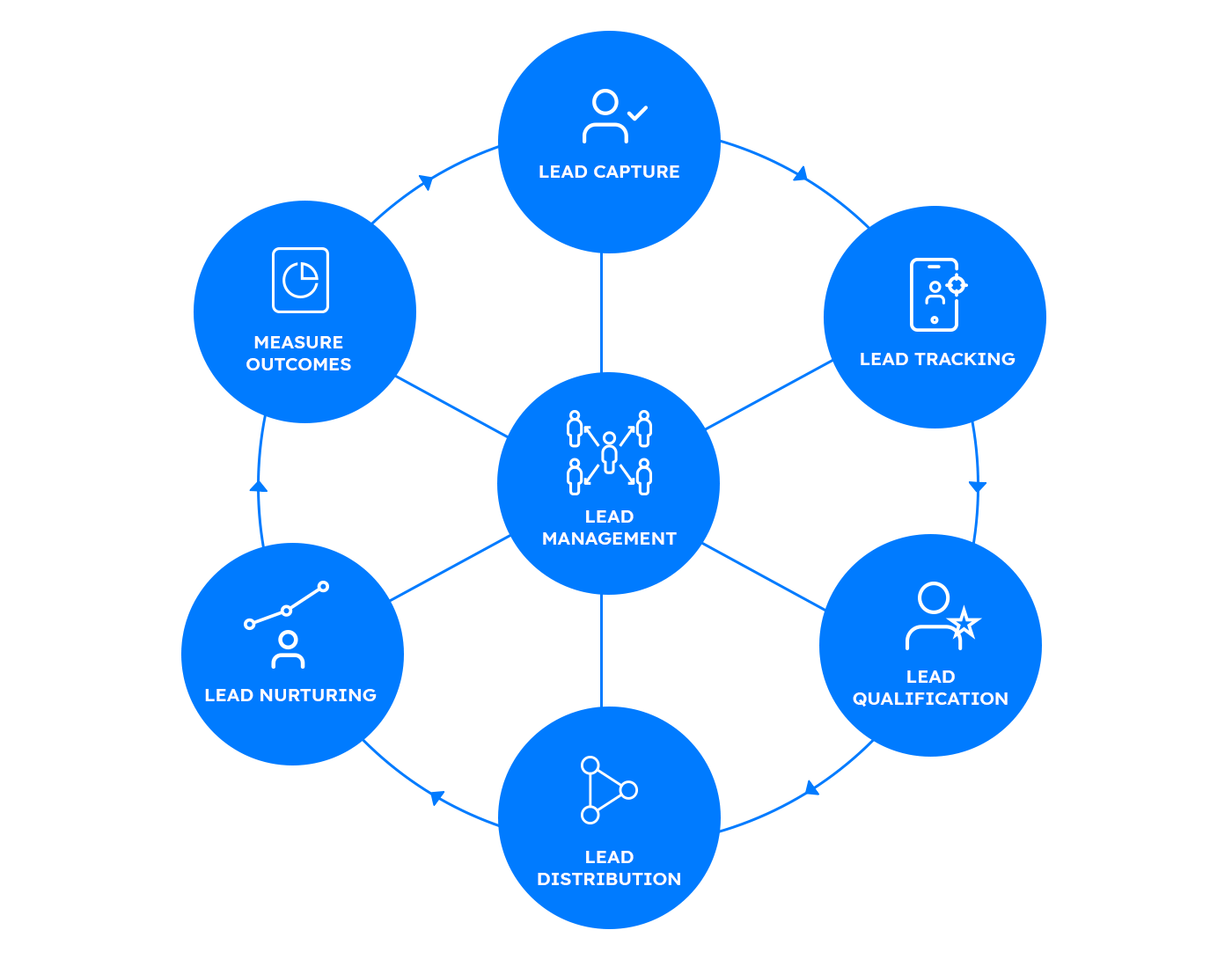
1. Capturing leads
Running sales and marketing campaigns for lead generation is one thing. Collecting and pursuing them is another.
Lead management binds your lead generation efforts with sales opportunities by collecting leads from several sources into one platform along with necessary information like source, campaign name, etc.
2. Lead tracking
Do you think having the email id and phone number of prospective customers is enough?
Not really.
You must also know if they’re interested in having a sales conversation. And you can gain this insight through lead tracking.
Lead tracking is an important aspect of lead management where you track leads’ activities, such as:
- Page visited on the website (if they visit your pricing page, it signals that they’re looking for a product/service)
- Email opens and clicks to assess if they’re interested in communication with your brand
- Response to phone calls, SMS, WhatsApp, etc.
Lead tracking is important also because it helps you recall the context during follow-ups. Utilizing the right lead management software can streamline this process, automating various communication channels and managing workflows effectively.
3. Lead qualification
67% of sales are lost due to improper lead qualification.
It happens when non-sales-ready leads enter the pipeline. That is why it is crucial to qualify leads based on:
- Interest to buy
- Capacity to buy
- Fitment (does your product serve their needs?)
There is no point in trying to sell to people who will never buy.
But still, you must record this information (along with reasons) for future reference. Lead management helps you organize the qualification data that you can access anytime.
4. Lead distribution
Let’s say you have a team of sales reps for different geographies and products.
How do you determine which lead should be assigned to which rep?
Lead distribution helps here.
For example, you can:
- Pass the lead to the US team if the location is California
- Or you can pass the lead to Jack if they’re interested in Product A
Similarly, you can have your own lead distribution logic.
Lead management ensures that the right lead is assigned to the right sales rep and the information is available across the board so that all team members are on the same page.
5. Nurturing leads
Lead nurturing is a thoughtful process of building relationships with leads to turn them into qualified prospects. Businesses have seen direct revenue benefits through lead nurturing programs.
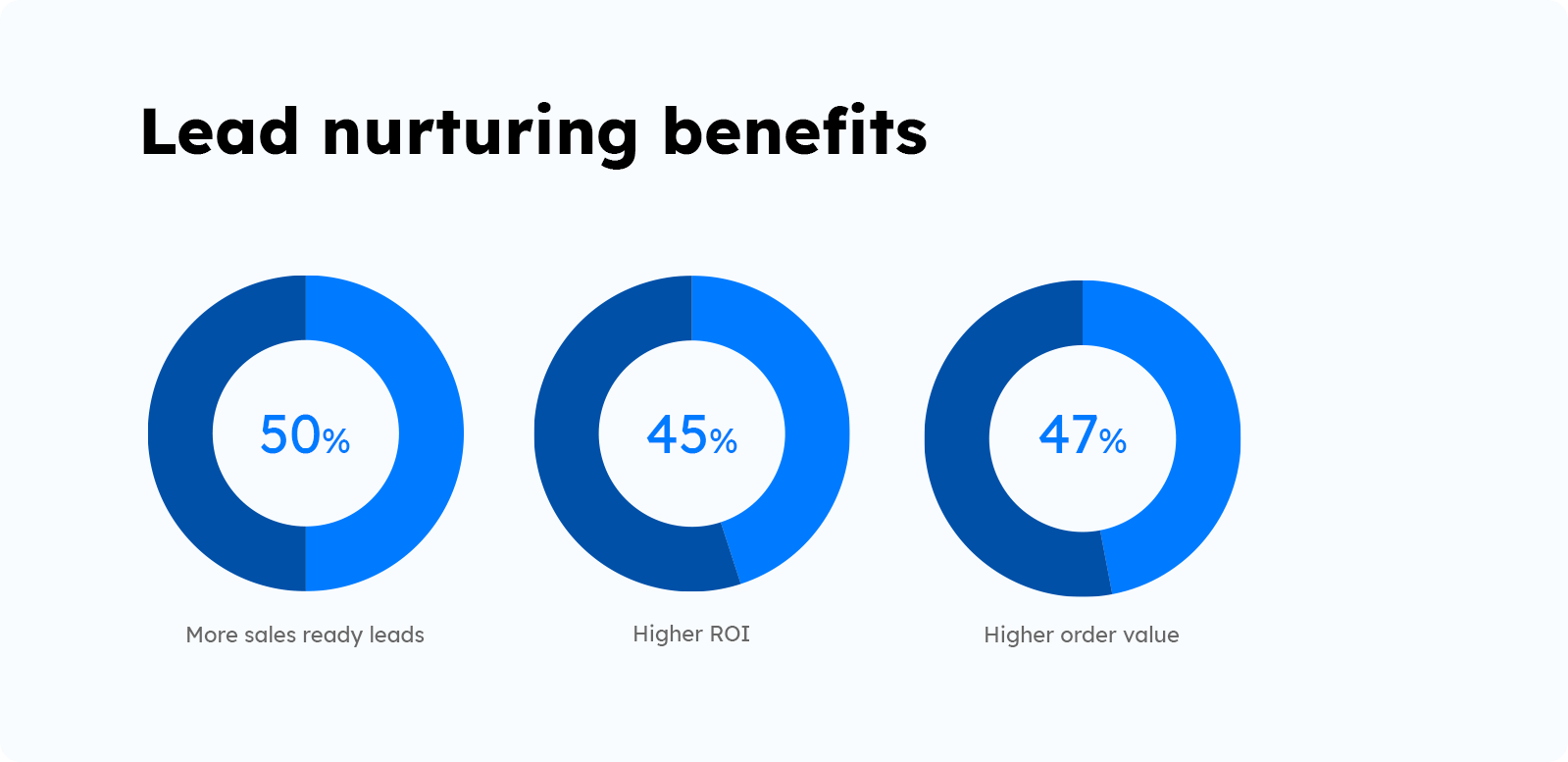
Lead management involves setting up and tracking your nurturing campaigns – and boosting your sales.
But does lead management stop once you convert a lead into a paying customer?
No. It doesn’t.
Earlier, lead management was defined as methodologies, systems, and practices designed to generate new potential business clientele. But today, it also incorporates strategies to retain customers. That is why people often use the terms lead management and CRM (customer relationship management) interchangeably.
While you may observe a difference in the way you deal with a lead vs. customer, lead management still applies. The following table pin-points the exact difference between a lead and a customer.
The Difference Between a Lead And a Customer
| Lead | Customer | |
| Definition | A person who has shown interest in your brand, product, service, or marketing content. | A person who has done business with you. That is, has bought your product or service. |
| Acquisition strategy | Brand awareness campaigns, content marketing, advertisements, etc. | Discounts, trials, demos, etc. |
| Engagement (nurturing) strategies | Brand/product awareness campaigns, building trust | Product/feature release updates, feedback, testimonials |
| Revenue potential | Through sales | Through subscription renewal, upsell and cross-sell |
| Sales probability | 5-20% | 60-70% |
It makes sense to foster relationships with customers (continue lead management) because:
- Acquiring new customers is 5 times more expensive than retaining them
- 82% of companies believe that customer retention is cheaper than acquisition
- A 5% increase in customer retention may lead to 25-95% higher profits
Let’s look at some more lead management benefits.
How Can Companies Benefit From Effective Lead Management?
Companies that do not have a well-defined lead management process are at risk of losing several sales opportunities due to:
- Lack of visibility into lead activities, stages, and duplications
- Improper lead qualification – making reps waste time pursuing the wrong leads
- Inefficient lead nurturing
In contrast, companies with a set process and tools to manage leads realize increased sales efficiency and conversions..
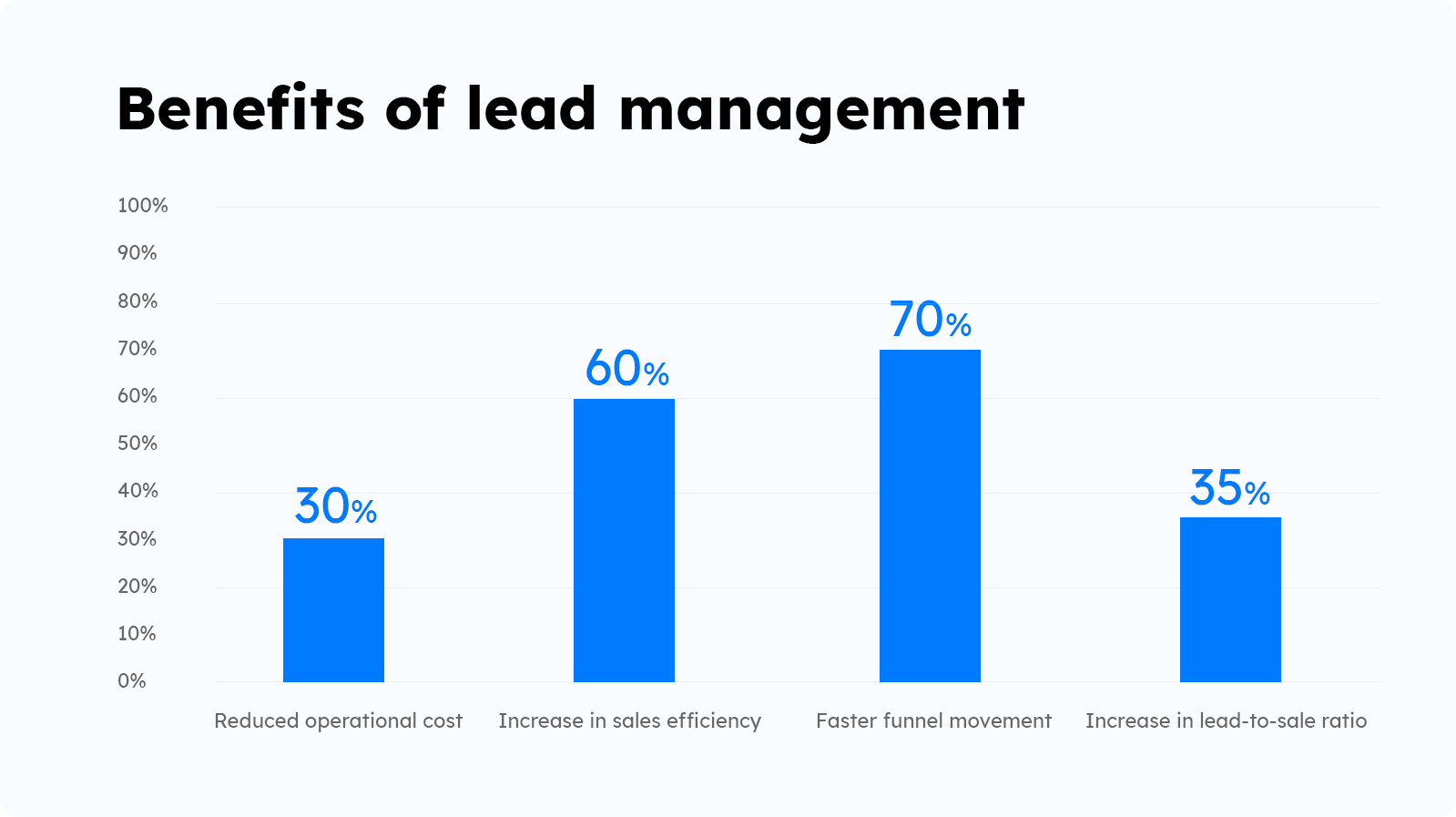
Lead management gives you the ability to:
- Fetch and organize lead data (identity, behavioral and engagement data)
- Map leads with sales owners and track interactions
- Visualize marketing and sales funnel in real-time
- Align sales and marketing
- Manage opportunities with leads and customers
However, with great power comes great responsibility.
Look at the following lead management best practices to streamline your sales operations.
Lead Management Best Practices
A study published in Forbes reveals that many companies struggle with, or are yet to update their lead generation and management strategies.
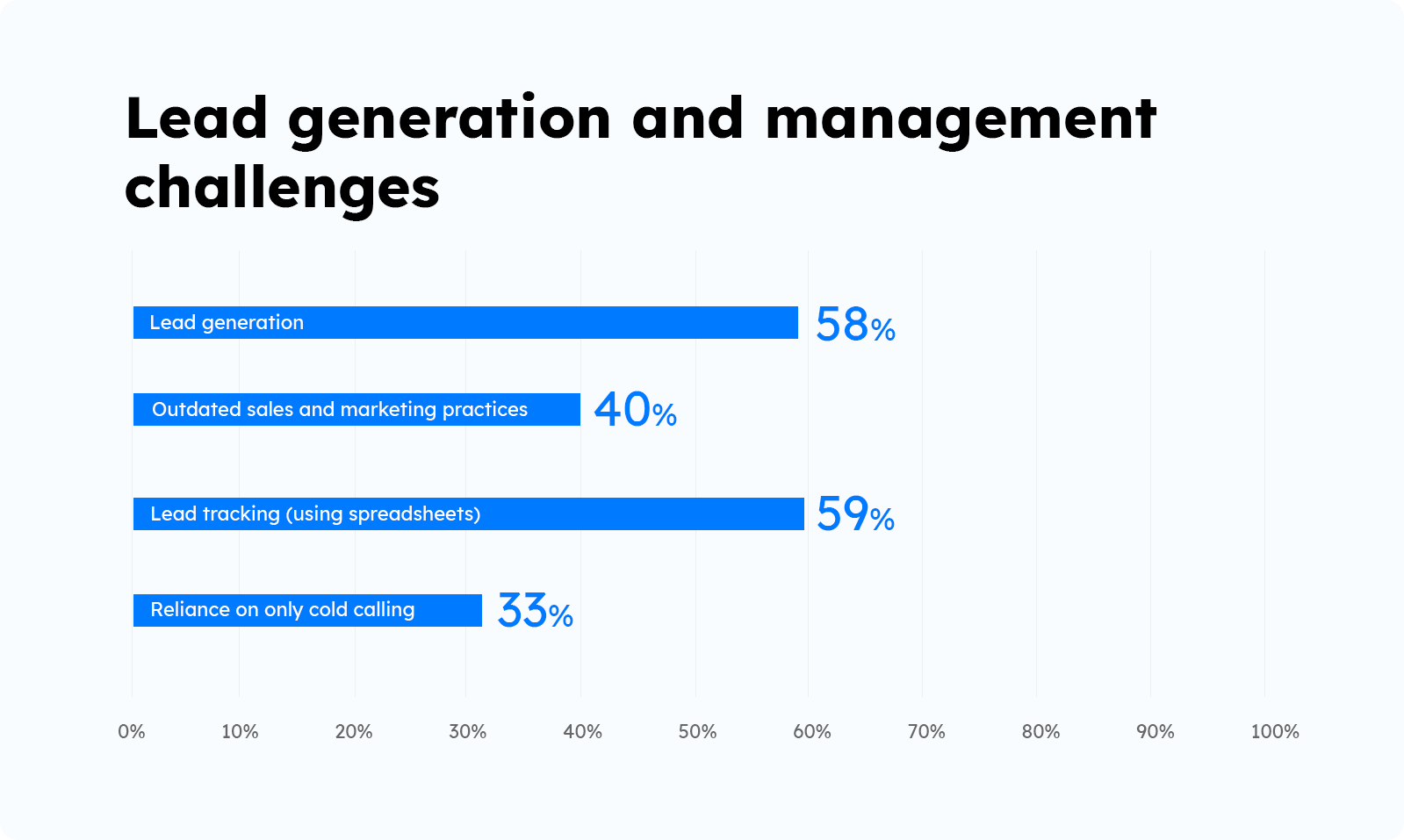
To overcome these challenges, follow these practices.
1. Track
Lead management is not only about tracking leads and customers. It involves tracking their stage in the sales funnel, activities that are driving movements, for example, follow-ups, nurturing, etc.
You’ll benefit from tracking the following metrics:
- Email metrics: number of emails sent, open and click rates, unsubscribe rate
- Pipeline report: number of leads in each stage of the pipeline for your team and every individual rep
- Calling report: call volume, connect rate, and successful conversation numbers
- Sales closure: deals your reps are closing or committing to the pipeline
- Activity vs. revenue report: revenue contributed by each rep vs. the nurturing activities performed by them.
- Lead source metrics: track the conversion rates by sources, campaigns, etc.
2. Define the lead management process internally
That is, all the team members – sales, marketing, customer support – are aware of the process. It is to prevent chaos and bad customer experience.
Imagine a lead getting calls from two of your sales reps pitching products at odd times while the lead is only looking for information about a topic.
That is why it is crucial to define your lead management process and bring all the team members on the same page.
For example, you can set a process that states a lead will be assigned to a sales rep only when they sign up for a demo, and only the designated lead owner will follow up with them.
3. Go omnichannel
Instead of relying on only one lead nurturing method (for instance, cold calling), try and test different lead engagement techniques such as:
- Email marketing
- Pay-per-click advertising
- Content marketing
- Social selling
- Webinars
- Offline events
Track your campaign performances and figure out the methods that resonate well with your target audience.
4. Measure
Say you have all the data about your prospects, customers, sales pipeline, etc. But what’s the point in having those data if you don’t put it to use.
That’s why you must define the metrics and measure them regularly. Then only you’ll be able to optimize your efforts and resources.
You can also use lead management tools to organize data and see reports automatically. You can track and measure the following KPIs in your lead management tool.
3 Most Important Lead Management KPIs
1. Leads to SQL (sales qualified lead) conversion rate
To explain this concept, let me propose three scenarios.
1. A visitor comes across your landing page and requests a demo.
2. A visitor signs up for your newsletter.
3. The same visitor asks for a quotation after reading your product newsletter.
In the first scenario, the lead is an SQL and can enter your sales pipeline directly.
In the second scenario, the lead is just seeking information and may not be ready to talk to your sales reps yet.
In the third scenario, which is an extension of the second, the lead finds interest in your product after reading your marketing content. So, they transition from being just a lead to SQL.
The lead to SQL conversion rate determines the percentage of leads that enter the pipeline. It is an important metric because it gives you an insight into the potential sales opportunities.
For example,
We classify leads as SQL if they register for a free trial or demo. Through our lead management CRM, we track the first point of interaction (ads, blog articles, events, etc.) and how they transition from one stage to another. We also check channels that bring us the maximum number of qualified leads and adjust spending accordingly.
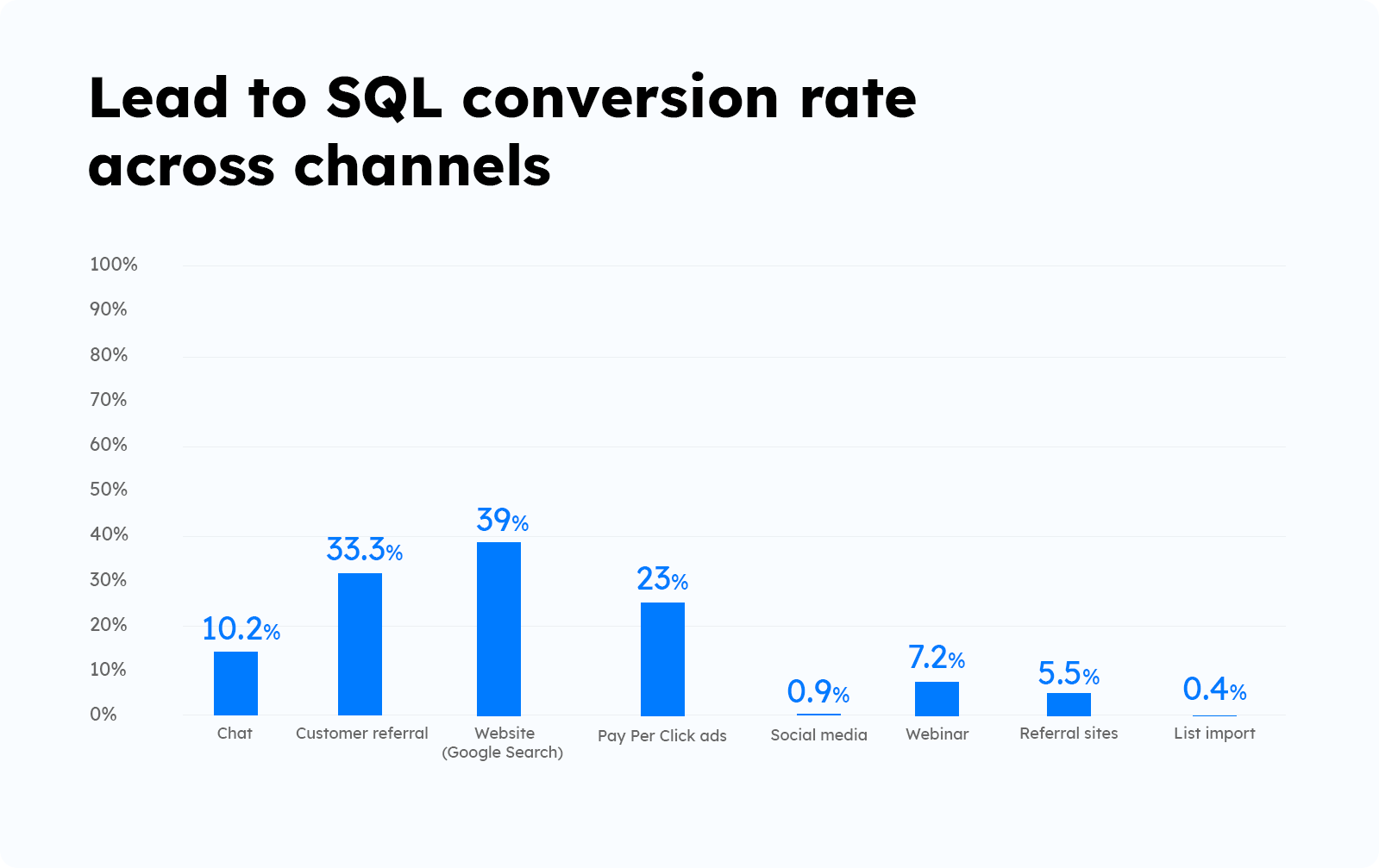
2. Lead conversion rate or lead-to-sale conversion rate
This metric determines how many leads convert into sales and drive revenue.
While it’s okay to have an overview of this number on a monthly, quarterly, or yearly basis, details like lead conversion by source, sales reps, etc., help you get a clearer picture of the activities that lead to sales.
For example, we recently saw the following conversion (lead-to-sale) rate across channels:
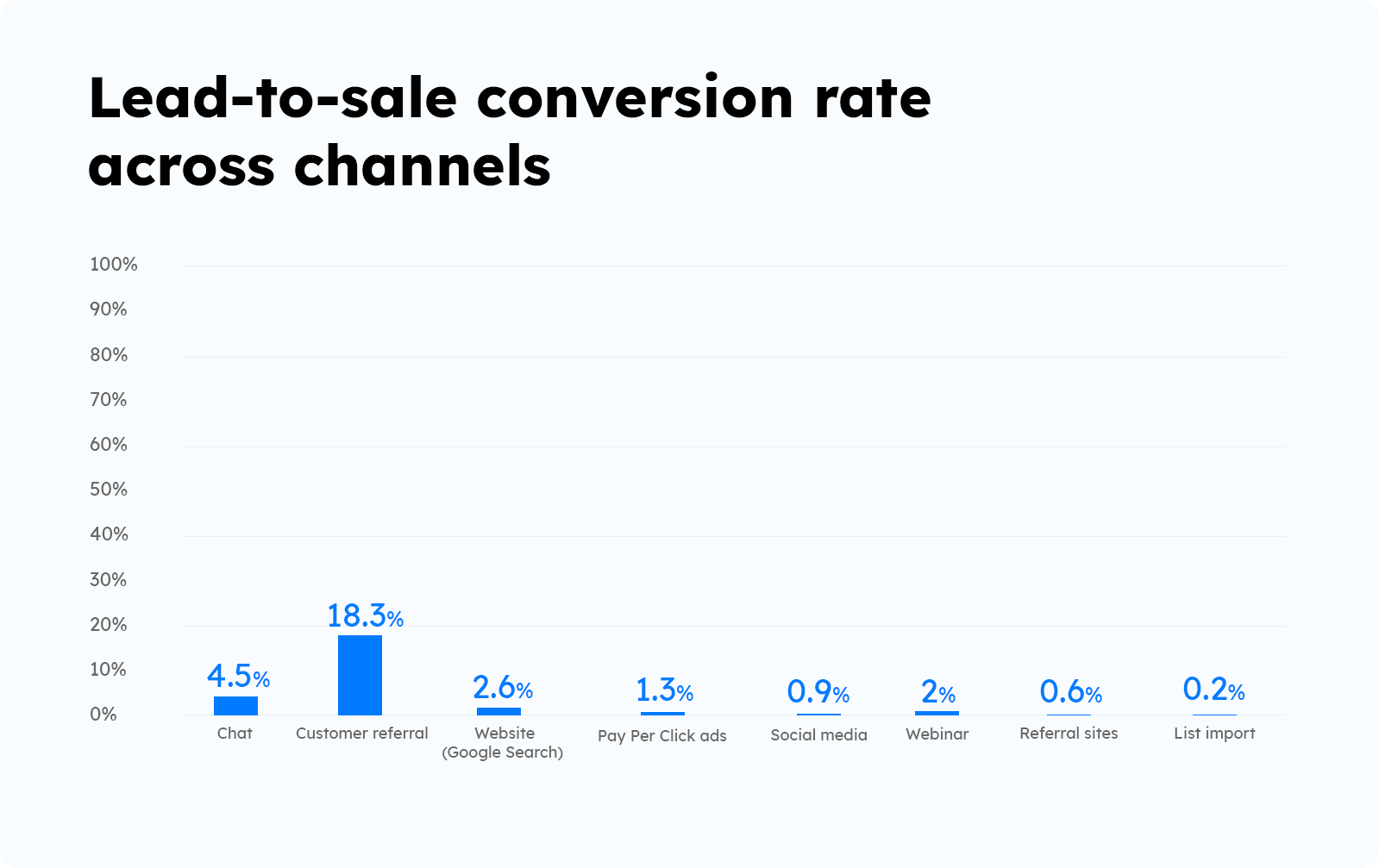
We could only measure it because we have a lead management system in place. It helps us identify the sources that are performing well and invest more in them. It also helps us figure out the non-performing sources and devise measures to improve them.
3. Sales cycle
A lead must pass through certain stages to become a prospect and eventually a customer. The sales cycle is the average time it takes to close a sale (from the first contact to becoming a paying customer).
A sales cycle is measured in the number of days.
How long is your sales cycle? Are they short or too long?
MarketingSherpa asked 15 marketers across 13 different industries to share their average sales cycle length. While not a benchmark, they provide insight into how each industry differs.
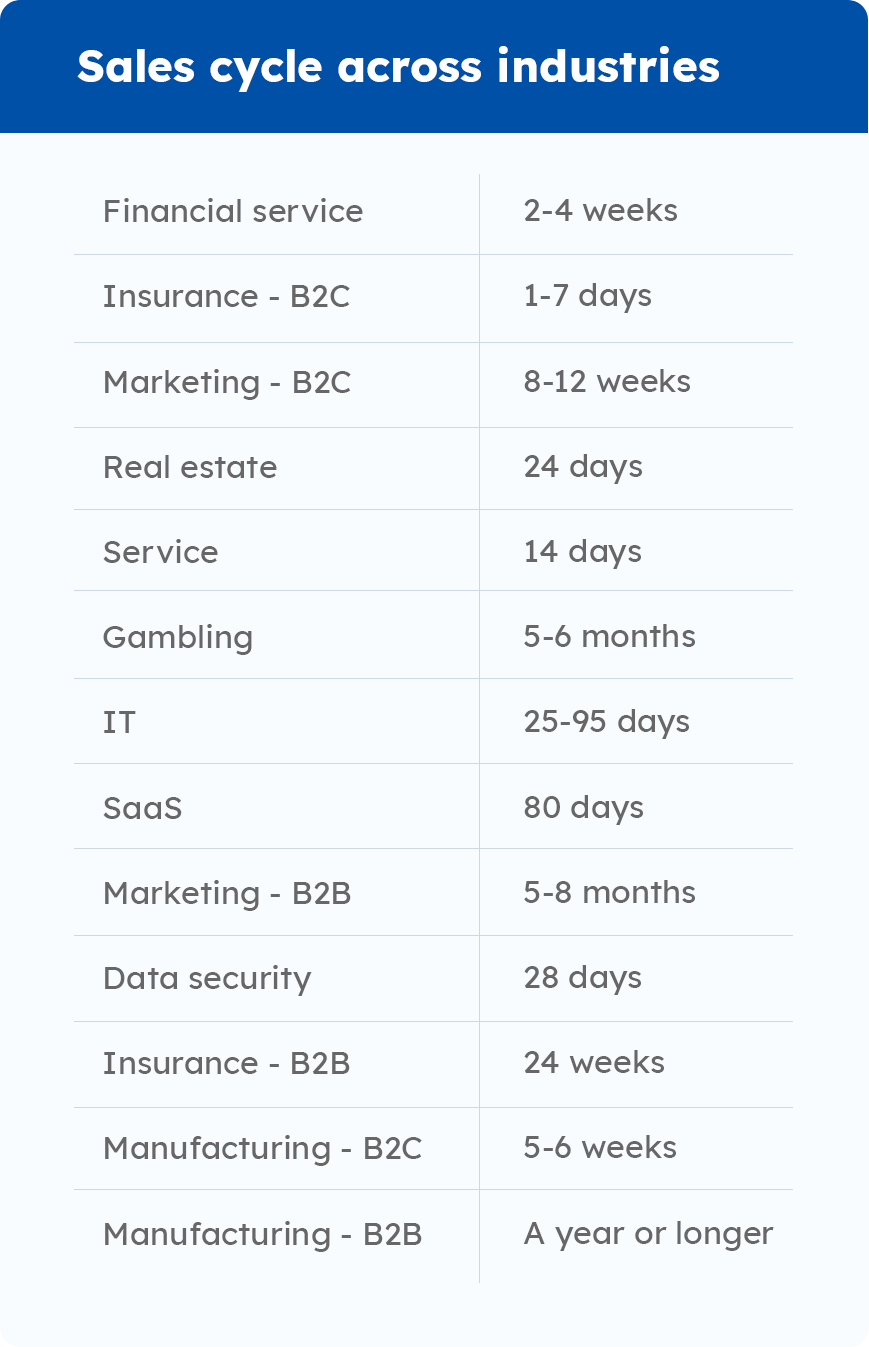
So, now you have more insight – what do you do with it?
Understanding how fast or slow your sales cycle is crucial because it helps you find the bottlenecks in the process.
For example, if leads stop communication after initial contact, you might want to look into your nurturing activities. Or, if leads don’t convert after a demo, maybe you should check lead qualification criteria or expand your SDR team.
Lead management helps you keep a tab on all these metrics (and more) to improve sales.
Let’s look at some of the best lead management tools and their features and how companies have achieved greater sales efficiencies with these tools.
Key Features of a Lead Management System
A lead management system typically includes the following key features:
- Lead capture: The ability to capture leads from various sources, such as websites, social media, and email marketing campaigns. This ensures that all potential leads are collected and stored in one centralized location.
- Lead tracking: The ability to track leads throughout the sales funnel, including their interactions with the business. This helps in understanding the lead’s journey and identifying the best times to engage.
- Lead scoring: The ability to score leads based on their behavior, demographics, and other criteria to determine their qualification. This prioritizes leads that are more likely to convert, allowing sales teams to focus their efforts effectively.
- Lead nurturing: The ability to nurture leads through targeted marketing campaigns and personalized communication. This builds relationships and keeps leads engaged until they are ready to make a purchase.
- Sales pipeline management: The ability to manage the sales pipeline, including tracking deals, opportunities, and customer interactions. This provides a clear view of the sales process and helps in forecasting revenue.
- Customer relationship management: The ability to manage customer relationships, including contact information, interactions, and preferences. This ensures that all customer data is organized and accessible, facilitating better communication and service.
- Reporting and analytics: The ability to generate reports and analytics to measure the effectiveness of lead management efforts. This provides insights into what is working and what needs improvement, helping businesses to optimize their strategies.
Best lead management tools
1. LeadSquared lead management CRM
LeadSquared combines the features of lead management and CRM software and helps with lead, customer, and sales team management in one platform.
Key Features:
- Sales automation with lead capture automation, lead distribution, and sales funnel movement.
- Mobile CRM to enable, track, and manage field sales.
- Built-in-dialer to track and record conversations for quality assessment and training.
- Real-time dashboard and reports: Over 135+ reports help you measure every piece of your process – from campaign spending to sales closure rates.
- API and custom integrations seamlessly transfer data and maintain integrity across channels (WhatsApp, ads, marketplaces, etc.).
Pricing:
- Lite – $25 per user/month
- Pro – $50 per user/month
- Super – $100 per user/month
2. HubSpot lead management and tracking software
A part of HubSpot CRM, this sales lead management software helps you manage all your lead records in a centralized database, track and score leads, see communication history, create segmented lists, and streamline outreach, thereby enhancing your sales processes.
Key Features:
- Pipeline management: Allows adding deals with a single click, assigning tasks to push deals forward, and tracking progress on dashboards.
- Email tracking to send timed follow-ups.
- Meeting scheduling: Allows creating scheduling links to book a timeslot on your calendar.
- Live chat and chatbots to connect with website visitors in real-time.
Pricing:
- Starter – $20 per month
- Professional – $500 per month
- Enterprise – $1200 per month
3. Freshworks lead management software
Freshsales comes with built-in lead management features, where leads are automatically captured and enriched in the CRM database. It allows users to track lead activities, qualify them with AI-powered contact scoring, segment leads, and nurture them.
Key Features:
- AI-powered lead scoring model for lead qualification. It uses historic data to automatically rank leads.
- Auto-profile enrichment to get better insights about prospects and customers.
- Less than a month’s implementation time.
Pricing:
- Growth – $29 per user/month
- Pro – $69 per user/month
- Enterprise – $125 per user/month
4. Zoho lead management software
Zoho is known the best for it’s ticketing service but it also offers lead management services including lead capture and nurturing.
Key Features:
- Sales force automation speeds up sales tasks, minimises error, and ensures that no follow ups are missed.
- Process management solutions to manage orders, vendors, and distributors.
- Sales forecasting tool builds custom forecasts for chosen metrics.
- Analytics for insight into leads, deals, and sales activities.
Pricing:
- Bigin – $0 per user/month
- Standard – $14 per user/month
- Professional – $23 per user/month
- Enterprise – $40 per user/month
- Ultimate – $52 per user/month
5. Pipedrive lead management software
Pipedrive is a pipeline management and sales CRM tool that allows businesses to qualify leads, engage with them, and segment contacts to improve efficiency.
Key Features:
- Pipeline management that tracks sales deals, lead stages, and sales revenue.
- Automated email workflows to engage prospects and automate follow ups.
- Daily work scheduler for higher sales efficiency and streamlined sales tasks.
- Contact management using custom fields to filter your prospect list for campaigns and communication.
Pricing:
- Essential – $9.90 per user/month
- Advanced – $19.90 per user/month
- Professional – $39.90 per user/month
- Enterprise – $59.90 per month
Now let’s see how companies have increased their lead-to-sale conversion rate with effective lead management.
Choosing the Right Lead Management Tools
Choosing the right lead management tools is crucial for businesses to succeed in their lead management efforts. Here are some factors to consider when selecting lead management tools:
- Ease of use: The tools should be easy to use and navigate, even for non-technical users. A user-friendly interface ensures that all team members can efficiently utilize the system without extensive training.
- Integration: The tools should integrate with existing systems, such as CRM, marketing automation, and email marketing software. Seamless integration ensures that data flows smoothly between different platforms, enhancing overall efficiency.
- Customization: The tools should allow for customization to meet the specific needs of the business. This flexibility ensures that the system can adapt to unique workflows and processes.
- Scalability: The tools should be scalable to accommodate growing lead volumes and business needs. As the business expands, the lead management system should be able to handle increased data and user demands.
- Cost: The tools should be cost-effective and provide a good return on investment. It’s important to balance the features and benefits of the tool with its price to ensure it fits within the budget.
- Support: The tools should provide good customer support and training to ensure successful implementation and use. Reliable support ensures that any issues are quickly resolved, and users can make the most of the system.
By considering these factors and selecting the right lead management tools, businesses can improve their lead management efforts, increase sales, and build strong relationships with their customers. The right tools not only enhance the efficiency of the lead management process but also provide valuable insights that drive strategic decision-making.
Leading ed-tech firm improves their sales conversions with LeadSquared!
One of the world’s leading ed-tech companies faced many challenges in its initial days, such as internet penetration, data availability, and cost. It has an elaborate customer lifecycle and relies heavily on historical data. For instance, there is a higher probability of app installs and re-installs during new academic sessions.
They were using Excel and Google Sheets, but it just couldn’t cut it. Hence, they realized the need for a lead and customer management system.
In Conclusion
Lead management is crucial for fast-growing organizations.
It gives clear visibility into the sales pipeline and helps you make better business decisions with ample customer and sales data and actionable insights.
If you want to manage leads more efficiently and increase sales – just like some companies such as BYJU’S, AllState, Amazon Pay, DSR Leasing, and more, sign-up for free with LeadSquared.
FAQs
Lead management CRM is a software tool that serves the purpose of both lead management and customer relationship management.
Lead conversion rate is an important sales metric. To calculate it, divide the number of customers by the number of leads you generated in any given period. You can also use a lead management system to track this metric in real-time.
A sales opportunity (or opportunity) is an individual with a high chance of becoming a customer. Opportunity also refers to the potential up-selling/cross-selling possibilities with an existing customer.
Here’s a list of terminologies you’ll come across in your lead management journey.
The lead management software that is the best fit for your business depends on the tool’s scalability, customizability, and scope of integration. The top 5 lead management software for businesses of all sizes are:
1. LeadSquared
2. HubSpot
3. Pipedrive
4. Freshworks
5. Zoho









![25 Reasons to Use Website Live Chat for E-commerce Businesses [Infographic] 10 website live chat - comic](https://www.leadsquared.com/wp-content/uploads/2022/04/cover-7-80x80.png)